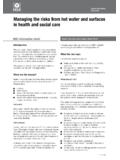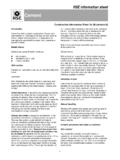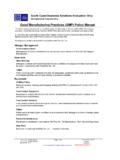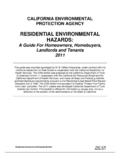Transcription of SPHAEROBOLUS SPP.--THE ARTILLERY FUNGUS
1 Dr. Sharon M. Douglas Department of Plant Pathology and Ecology The Connecticut Agricultural Experiment Station 123 Huntington Street, P. O. Box 1106 New Haven, CT 06504 Phone: (203) 974-8601 Fax: (203) 974-8502 Founded in 1875 Email: Putting science to work for society Website: SPHAEROBOLUS ARTILLERY FUNGUS The presence of persistent brown to black spots on cars, house siding, plants, and other surfaces may be an indication of the presence of the FUNGUS SPHAEROBOLUS spp.
2 These brown spots are spore masses called peridioles or glebal masses, which are approximately 1-2 mm (1/12 inch) in diameter. They are the dispersal structures of SPHAEROBOLUS . This FUNGUS is a Basidiomycete and a member of the class Gasteromycetes, family Sphaerobolaceae. (However, molecular data now suggest that this species might be better placed in the family Geastraceae) SPHAEROBOLUS is a cosmopolitan saprophyte (decay organism) found on wood and bark chips, dead and decaying wood, and dung and is not considered a pathogen of plants, animals, or humans.
3 The increased prevalence of this FUNGUS during the past ten years appears to be partly associated with the increased popularity and use of bark and wood chip mulches in the landscape. SPHAEROBOLUS is commonly called the ARTILLERY FUNGUS or sphere thrower since it forcibly ejects its spore masses (called peridioles or gleba) for considerable distances. Peridioles can be projected vertically for more than 2 m (6 ft) and horizontally for over 6 m (20 ft).
4 Some researchers have also reported that the discharge is accompanied by an audible sound. As with most fungi, growth of SPHAEROBOLUS is influenced by temperature, light, and moisture. It grows better under wet conditions and is most commonly a problem during the cool, wet conditions of spring and fall. It is much less problematic during the hot, dry periods of midsummer. For much of its life, this FUNGUS consists of a mass of white, thread-like filaments called hyphae, which aren t readily visible to the naked eye (Figure 1).
5 Figure 1. Magnified view of white, thread-like filaments (hyphae) (arrows) of SPHAEROBOLUS growing on wood chips. SPHAEROBOLUS spp. The ARTILLERY FUNGUS S. M. Douglas The Connecticut Agricultural Experiment Station ( ) 2 However, the presence of this growth can sometimes be recognized as matted or gray, somewhat bleached areas in a mulch bed. This bleaching is attributed to the digestion of the lignin, cellulose, and hemicellulose in the wood, as it is colonized by the FUNGUS .
6 Fruiting structures (called basidiocarps) usually form on substrates (wood chips, bark, dung, or decaying plant material) in autumn and spring. They are small, spheres approximately mm (1/10 inch) in diameter and buff to yellow in color (Figure 2). Because of their size, they are very difficult to find in the mulch. Figure 2. Early stages of developingbasidiocarps (arrow). As the fruiting structures mature, outer walls of the basidiocarps rupture, giving the structures a star or nest-like appearance.
7 As they open, the peridioles or gleba are visible as dark masses at the bottom of the opening structures (Figure 3). Increases in osmotic pressure, possibly due to the conversion of glycogen to sugars, cause the membranes under the peridioles to swell and turn inside out. This process provides the force (estimated to be 1/10,000 horsepower) to propel or eject the peridioles into the air. After the peridioles are discharged, the swollen, inner membranes remain visible as glossy protrusions in the basidiocarps (Figure 4).
8 These fruiting structures usually remain active or shoot for approximately 2-3 weeks . Figure 3. Basidiocarps splitting to form star-like nests. Note the peridioles (dark objects at bottom of each nest ) before they are shot. Figure 4. The glossy protrusion visible after the peridioles are discharged. Adequate light and moisture are also necessary for ejection or discharge of peridioles. The ejection process is phototropic, which means that the peridioles are projected towards light and light-colored objects ( , white cars, beige houses).
9 Peridioles are typically quite sticky and, since they are forcibly ejected, they readily SPHAEROBOLUS spp. The ARTILLERY FUNGUS S. M. Douglas The Connecticut Agricultural Experiment Station ( ) 3dhere to objects upon which they are impacted (Figures 5 and 6). a Figure 5. SPHAEROBOLUS spp. growing on ood chips in a petri dish. Note the brownwperidioles shot onto the lid. Figure 6. Close-up of peridioles stuck to thelid of plastic petri dish after being shot fromfruiting bodies.
10 Note the flattened appearance due to impact and the sticky halof material adhering the peridiole to thehae and peridioles can lso be dispersed by wind or over long y bstrates in forests, woodlots, and home uosurface. When the peridioles dry, they become very difficult to remove (Figure 7). Unfortunately, SPHAEROBOLUS can be long-lived and peridioles have been found to still be viable for up to 12 years. In addition to growing on wood and bark mulches, SPHAEROBOLUS hypadistances in plant debris, mulch, animal fur, and animal dung.














